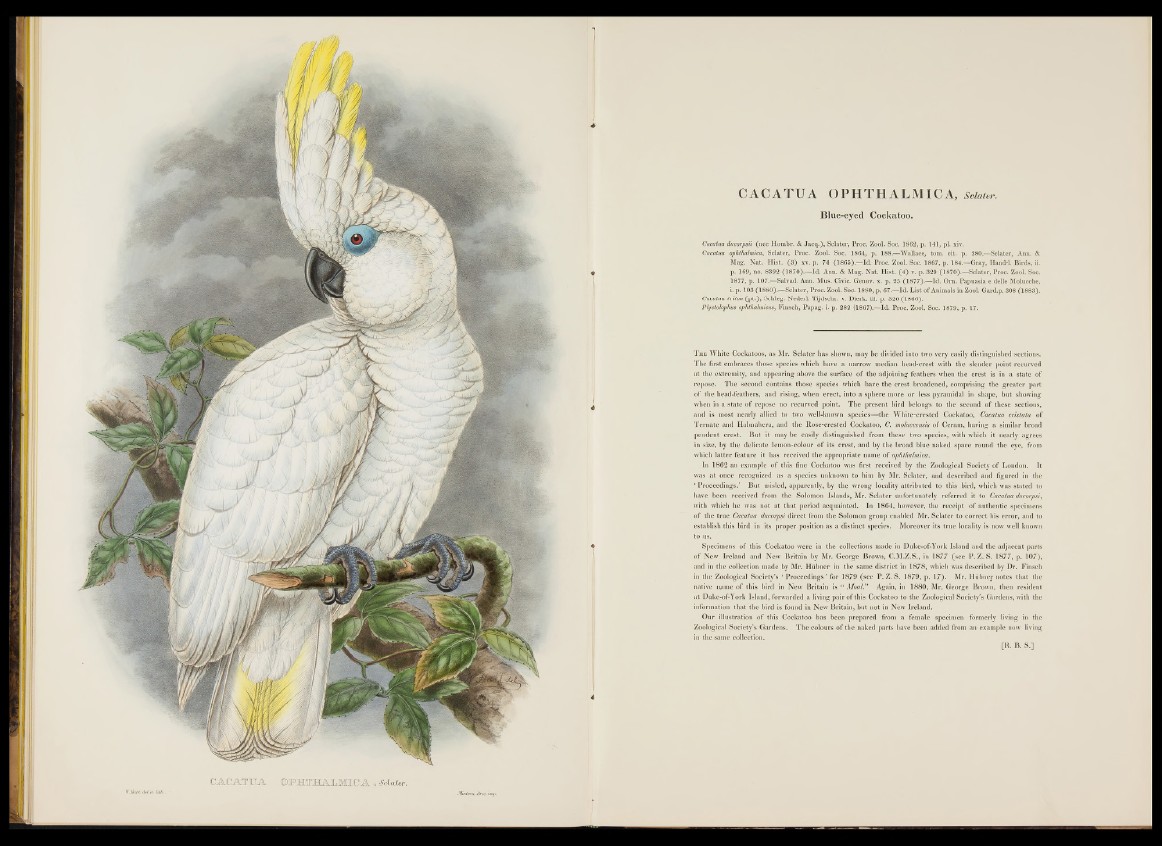
CA.CA.TUA. OPHTHALMIC A , Sclater.
CACATUA OPHTHALMIC A, Sclater.
Blue-eyed. Cockatoo.
Cacatua ducorpsii (nec Hombr. & Jacq.), Sclater, Proc. Zool. Soc. 1862, p. 141, pi. xiv.
Cacatua ophthalmica, Sclater, Proc. Zool. Soc. 1864, p. 188.—Wallace, tom. cit. p. 280.—Sclater, Ann. &
Mag. Nat. Hist. ( 3 ) xv. p. 74 (1865).—Id. Proc. Zool. Soc. 1867, p. 184.—Gray, Hand-1. Birds, ii.
p. 169, no. 8392 (1870).—Id. Ann. & Mag. Nat. Hist. (4 ) v. p. 329 (1870).—Sclater, Proc. Zool. Soc.
1877, p. 107.—Salvad. Ann. Mus. Civic. Genov, x. p. 25 (1877).—Id. Orn. Papuasia e delle Molucche,
i. p. 103 (1880).—Sclater, Proc. Zool. Soc. 1880, p. 67.—Id. List of Animals in Zool. Gard.p. 308 (1883).
Cacatua triton (p t.), Scbleg. Nederl. Tijdschr. v. Dierk. iii. p. 320 (1866).
Plyctolophus ophthalmicus, Finsch, Papag. i. p. 282 (1867).— Id. Proc. Zool. Soc. 1879, p. 17.
T h e White Cockatoos, as Mr. Sclater has shown, may be divided into two very easily distinguished sections.
T he first embraces those species which have a narrow median head-crest with the slender point recurved
at the extremity, and appearing above the surface o f the adjoining feathers when the crest is in a state of
repose. The second contains those species which have the crest broadened, comprising the greater part
o f the head-feathers, and rising, when erect, into a sphere more or less pyramidal in shape, but showing
when in a state o f repose no recurved point. The present bird belongs to the second o f these sections,
and is most nearly allied to two well-known species— the White-crested Cockatoo, Cacatua cristata of
T ernate and Halmahera, and the Rose-crested Cockatoo, C. moluccensis of Ceram, having a similar broad
pendent crest. But it may be easily distinguished from these two species, with which it nearly agrees
in size, by the delicate lemon-colour o f its crest, and by the broad blue naked space round the eye, from
which latter feature it has received the appropriate name o f ophthalmica.
In 1862 an example o f this fine Cockatoo was first received by the Zoological Society o f London. It
was a t once recognized as a species unknown to him by Mr. Sclater, and described and figured in the
‘ Proceedings.’ But misled, apparently, by the wrong locality attributed to this bird, which was stated to
have been received from the Solomon Islands, Mr. Sclater unfortunately referred it to Cacatua ducorpsi,
with which he was not a t th at period acquainted. In 1864, however, the receipt o f authentic specimens
o f the true Cacatua ducorpsi direct from the Solomon group enabled Mr. Sclater to correct bis error, and to
establish this bird in its proper position as a distinct species. Moreover its true locality is now well known
to us.
Specimens of this Cockatoo were in the collections made in Duke-of-York Island and the adjacent parts
o f New Ireland and New Britain by Mr. George Brown, C.M.Z.S., in 1877 (see P. Z. S. 1877, p. 107),
and in the collection made by Mr. Hiibner in the same district in 1878, which was d escribed by Dr. Finsch
in the Zoological Society’s ‘ Proceedings’ for 1879 (see P .Z . S. 1879, p. 17). Mr. Hiibner notes that the
native name o f this bird in New Britain is “ Moal.” Again, in 1880, Mr. George Brown, then resident
a t Duke-of-York Island, forwarded a living pair o f this Cockatoo to the Zoological Society’s Gardens, with the
information that the bird is found in New Britain, but not in New Ireland.
Our illustration o f this Cockatoo has been prepared from a female specimen formerly living in the
Zoological Society’s Gardens. T h e colours o f the naked parts have been added from an example now living
in the same collection.
[R. B. S.]